Coin lockers at Disneyland! Also what to do when you don't have a place or space to leave your belongings!
2024/11/25
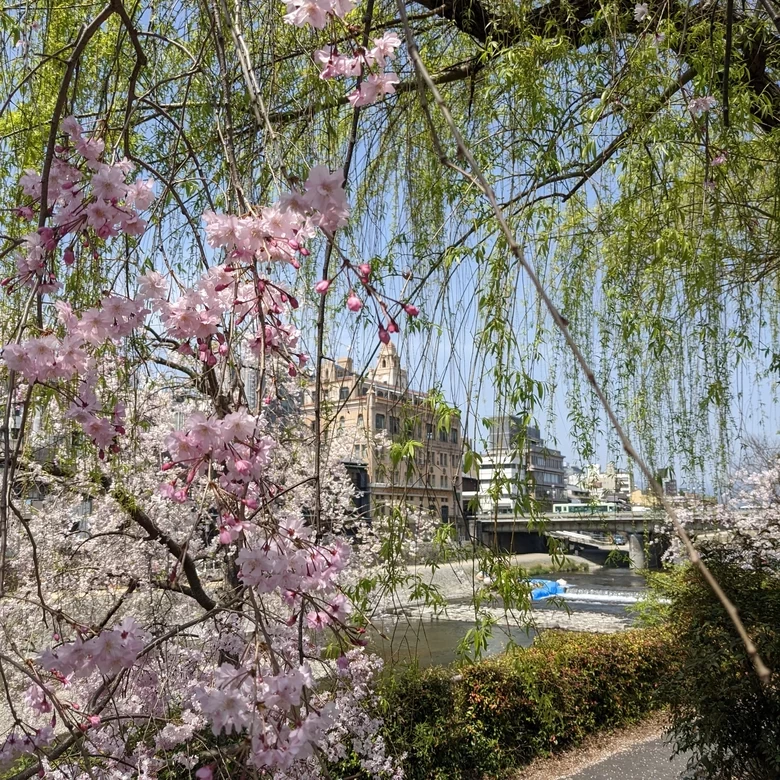
2025/04/01
We will introduce hidden cherry blossom spots in Kyoto that you can visit on foot, including Japanese gardens, museums, and newly renovated popular multi-use facilities.
Table of Contents of This Article
Open Table of Contents ▼
First, take a leisurely 10-minute walk from Kyoto Station to the Shosei-en Garden, located within the grounds of Higashi Honganji Temple. When you enter through the west gate, you'll see a deep pink weeping cherry tree right in front. If you enter through the north gate of the garden, a path lined with cherry blossoms stretches ahead.
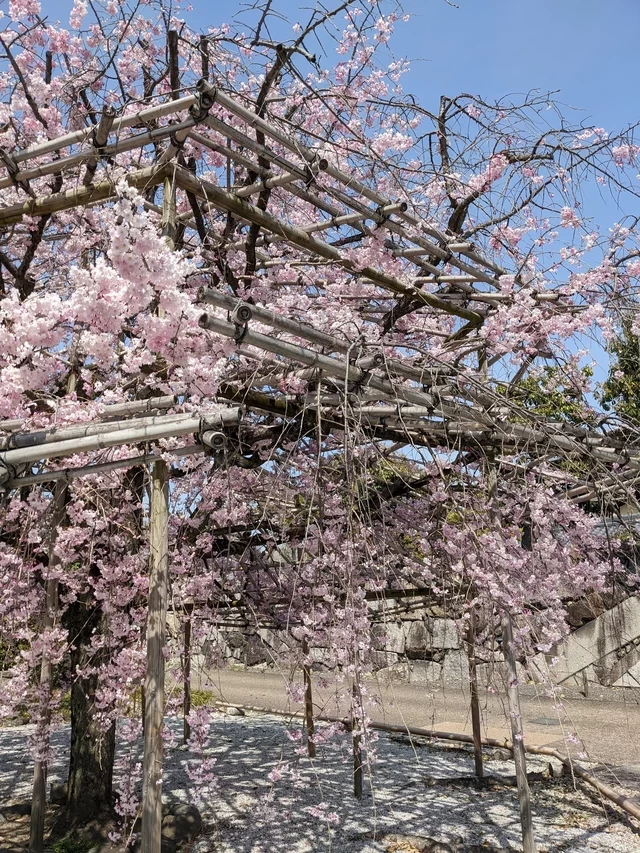
Shosei-en, designated as a Special Place of Scenic Beauty
What can be seen among the flowers is a building called Bokakaku Pavilion. This two-story structure has roofed stairs on both sides, allowing direct access to the second floor from the outside, which might seem like a strange design at first. You might wonder why such an unusual building was constructed, but from the outdoor stairs with no walls, you can feel the gentle fragrance of the flowers drifting in the air, perhaps making you feel the happiness of this season even more deeply.

The main gate of Shosei-en Garden and the Bokakakaku
On weekdays, there are few visitors, and a quiet, leisurely time flows by. In the large pond on the east side of the garden, the sunlight reflects off the water, creating a shimmering surface, and birds rest their wings between the ripples.
If you look back, you can see Kyoto Tower through the cherry blossoms. This place is like a little oasis, wouldn't you
Higashi Honganji Temple (東本願寺)
After enjoying a leisurely cherry blossom viewing at Shosei-en, we've started to get a little hungry. Let's go have lunch now!
Exit Shosei-en, cross the Kamo River, and walk toward the eastern mountain for a while. On your left, you’ll see a western-style mansion that looks like a castle. It’s the Kyoto National Museum. Across from it is Sanjusangendo Temple, so you can use that as a landmark to find your way here.
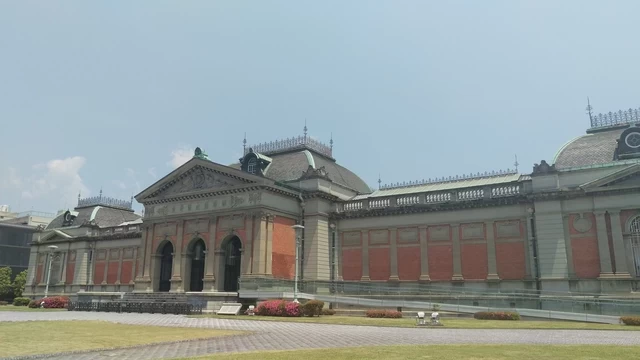
Kyoto National Museum
The Kyoto National Museum is a historic museum opened in 1897 (Meiji 30). Beyond the gate, there is a garden called the Eastern Garden, and on the right, you will find the Meiji Kotokan,designed by Tokuma Katayama, who also designed the Akasaka Palace State Guest House. On the left, there is a magnificent gate resembling that of a castle, and directly ahead is the modern Heisei Chishinkan, which opened in 2014. The museum regularly hosts fascinating special exhibitions, and during popular exhibitions, lines can often be seen.
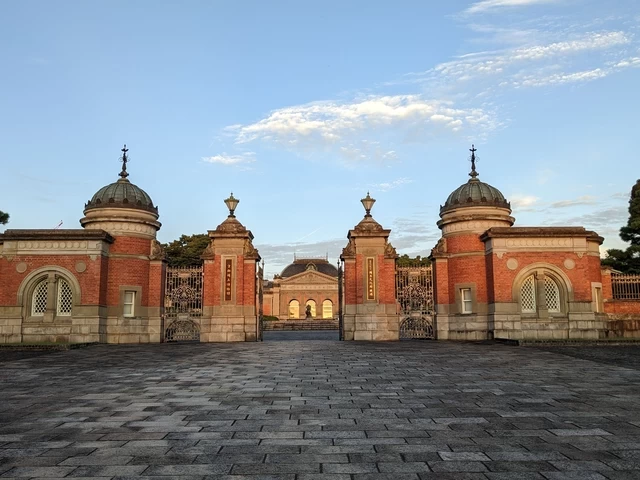
Now, the moment you've been waiting for. I came to eat a sandwich at Maeda Coffee Kyoto Museum Shop, which is next to the museum.
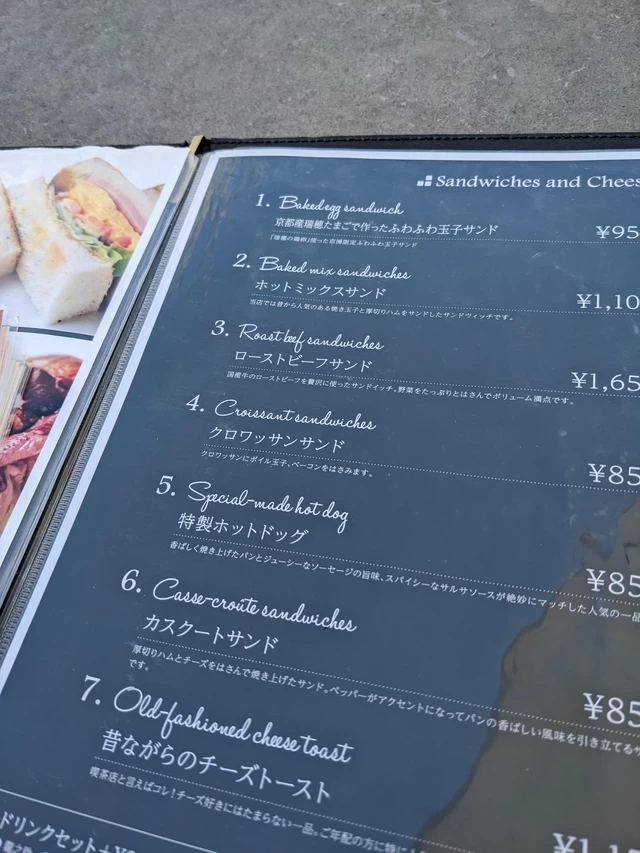
Don't miss out on the coffee, including the Kyoto Museum store's exclusive blend "Kyo"
If it's not too crowded, you can enjoy coffee while gazing at the blooming sakura trees at the Meiji Koto-kan from the terrace outside the shop. This time, I had the Fluffy Egg Sandwich (950 yen). The cherry blossom season is short, and the perfect timing is hard to come by, but if you get to watch the petals fluttering and falling into the pond on the terrace, that would probably be the perfect day. The shade of the trees can be a little chilly, so it's best to wait until the sun comes out before heading to the terrace.
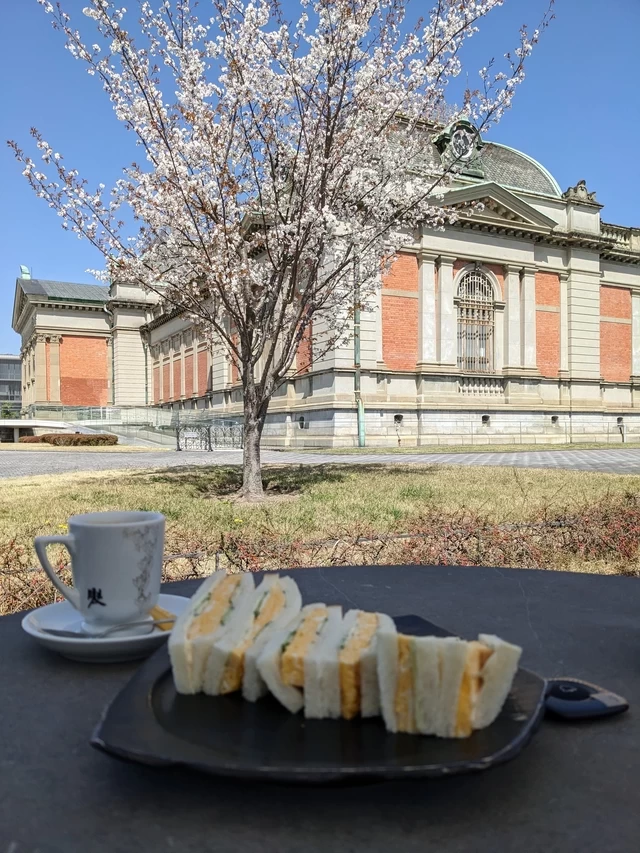
Can be used without entering the museum
Kyoto National Museum (京都国立博物館)
Maeda Coffee Kyoto Museum Shop (前田珈琲京博店)
We're full now, and the sun is still high, so let's walk along the Kamo River.
The river that stretches about 12 kilometers from the point where the Kamo River (加茂川, "Kamogawa" in Japanese) and the Takano River merge, all the way to where it joins the Katsura River on the western side of Chushojima, is called the Kamo River (鴨川, "Kamogawa" in Japnese). It turns out that the Kamo River(加茂川) and the Kamo River (鴨川) are slightly different. There are said to be 25 bridges across the Kamo River(鴨川) , with the famous ones being the Sanjo Ohashi and Gojo Ohashi, which were built by Hideyoshi.
Gojo Ohashi is the bridge associated with the famous story of Ushiwakamaru and Benkei having a fight. By the way, Ushiwakamaru is the childhood name of Minamoto no Yoshitsune, who is said to have fought bravely at Dan-no-ura, leading to the downfall of the Taira clan.
Today, we’ll head north from Shichijo Ohashi, which crosses the river just one bridge south of Gojo Ohashi.
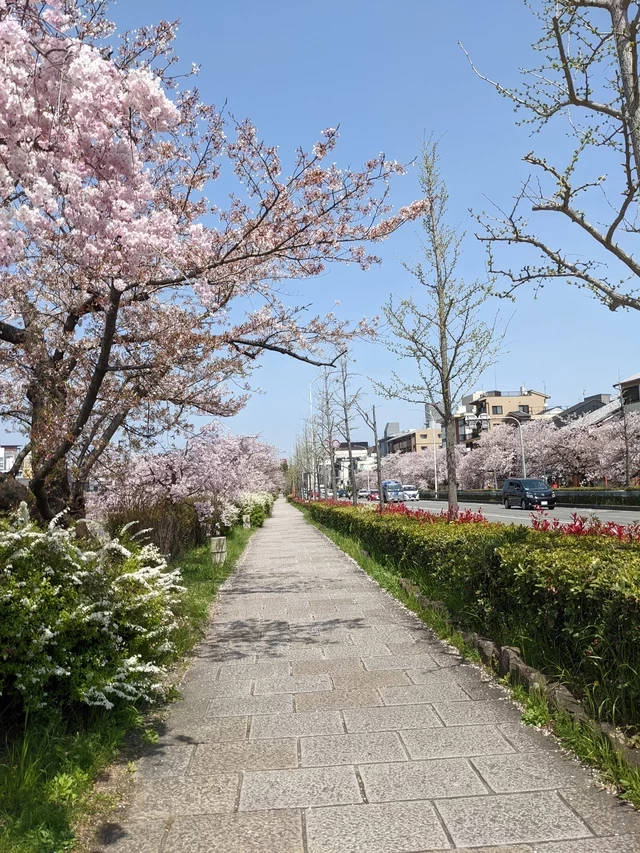
This path heading north along the eastern side of the Kamo River(鴨川) is truly a pleasant walking course. Along the river, there are waves of cherry blossoms. On the eastern side of the sidewalk, along Kawabata Street, cherry trees are planted all the way.
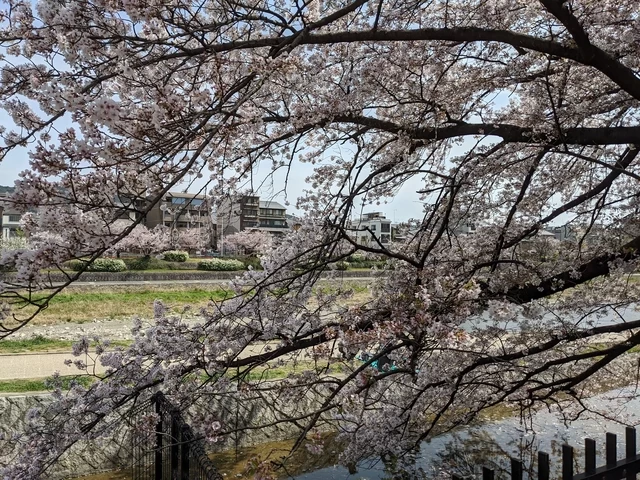
You can see the cherry blossoms on the opposite bank through the cherry-colored trees, right? Such a view continues for kilometers.
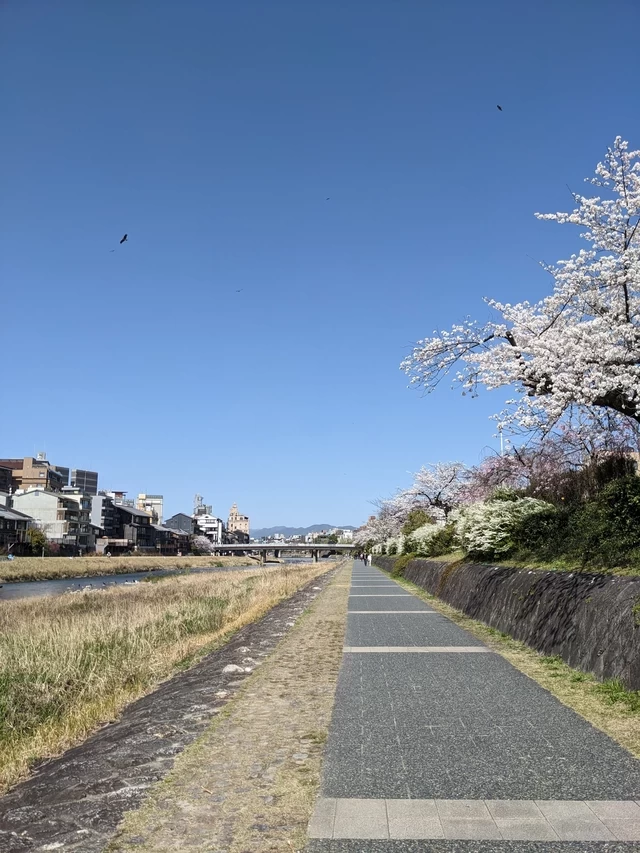
If you descend from the promenade to the riverbank, you’ll see spirea and rapeseed flowers swaying beneath the cherry blossoms. On warm days, sitting down and listening to the sound of the river is also the Kyoto way. From time to time, runners and cyclists pass by.
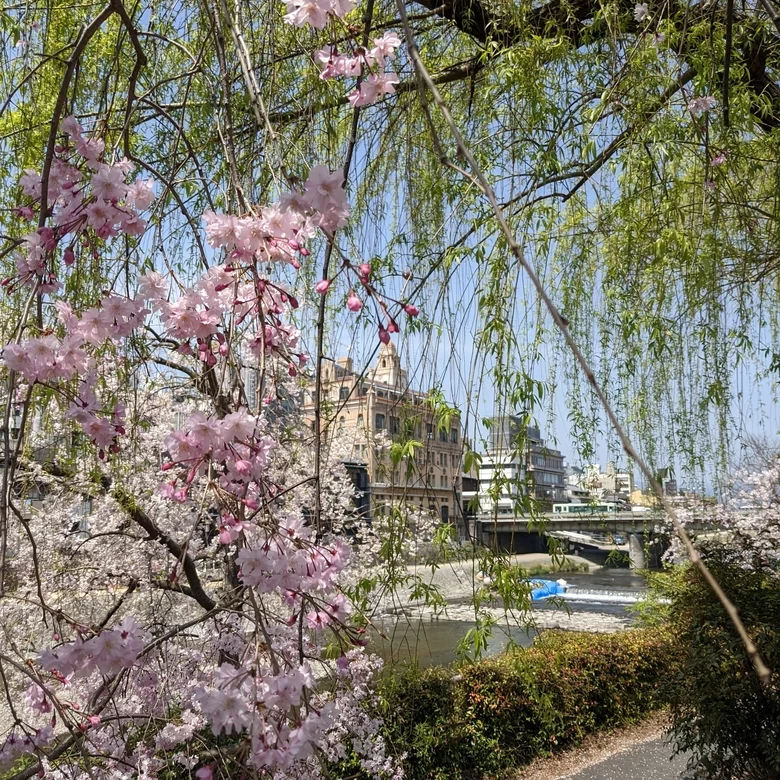
When you reach Shijo Bridge, you can see the luxurious building of Toka Saikan.As a Vories architecture.,the building is adorned with wonderful decorations everywhere, making it a mesmerizing sight. The elevator, which is still in use today, is said to be the oldest in Japan. It’s also worth seeing, but that’s for another time.
Let's head west from here and check out the Takase River that flows west.
Along the Takase River from Shijo Street to Oike Street is a famous cherry blossom spot. When alking at night, it’s lit up, and unlike during the day, the area transforms into a more glamorous and seductive-looking town.
This area is also full of many restaurants, and it’s also where the shishi (志士, revolutionary figures) from the late Edo period once walked proudly. If you walk carefully, you can find monuments related to those shishi, so it’s quite interesting.
Tired from walking so much, how about having some tea and heading back? This place is the Rissei Garden Hulic Kyoto, which was created by renovating the Rissei Elementary School that was opened in the second year of the Meiji era (1869). The first floor is a commercial and cultural facility, and the upper floors are a hotel.
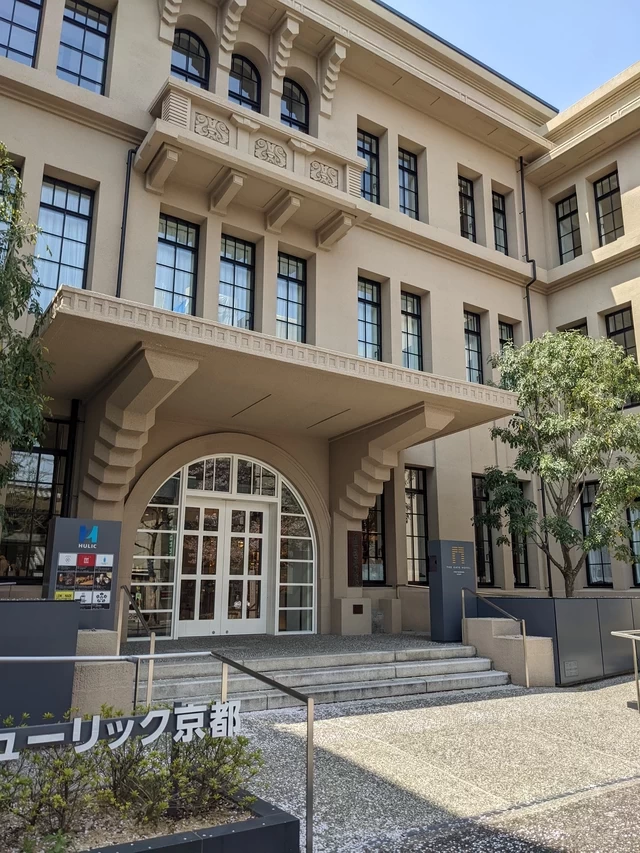
There are many noteworthy shops, including the first store of "cotoiro," a product brand by "Art Labo," a company that deals in scented goods.
There are remnants of the old elementary school all around the building, which gives a nostalgic feeling.
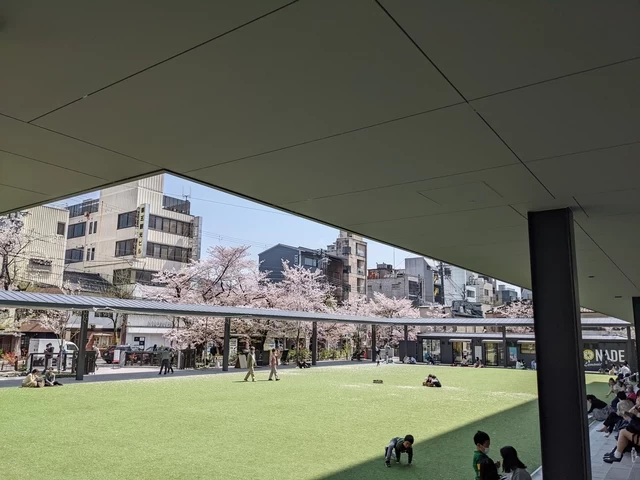
The lawn that used to be the schoolyard is still there, and of course, the cherry blossoms are blooming. Let’s sit on the grass and slowly drink the coffee we took out from the coffee shop. Ah, that feels so relaxing.
Well then, see you next time.

Was it helpful? Please try using it when traveling or going out.
Article planning/supervision:Reporter tabiiroLIKES member
writer:
Updated every Monday: Total number of views for 30 days

Coin lockers at Disneyland! Also what to do when you don't have a place or space to leave your belongings!
2024/11/25

Summary of Luggage Lockers (Coin Lockers) at Yokohama Station! Where Can You Find Free or Affordable Options?
2025/01/31

Which Shrines in Tokyo Offer the Chinowa Ring Kuguri Ritual? Learn About the Etiquette and Origins Before You Visit!
2024/11/27
![[Aichi Tourism] 20 Famous Cherry Blossom Spots Introducing the Best Spots for Cherry Blossom Viewing!](https://imgen.tabiiro.travel/kankou.tabiiro.jp/articles/images/1740626126-02_27_thum.jpg?w=180&h=180&mode=crop)
[Aichi Tourism] 20 Famous Cherry Blossom Spots Introducing the Best Spots for Cherry Blossom Viewing!
2025/02/21
![[Koshinetsu] 7 recommended amusement parks and theme parks to visit when sightseeing in Nagano](https://imgen.tabiiro.travel/kankou.tabiiro.jp/articles/images/1734075736-02_01_thum+%281%29.jpg?w=180&h=180&mode=crop)
[Koshinetsu] 7 recommended amusement parks and theme parks to visit when sightseeing in Nagano
2024/11/21
Higashi Honganji Temple (東本願寺)
Kyoto National Museum (京都国立博物館)
Maeda Coffee Kyoto Museum Shop (前田珈琲京博店)